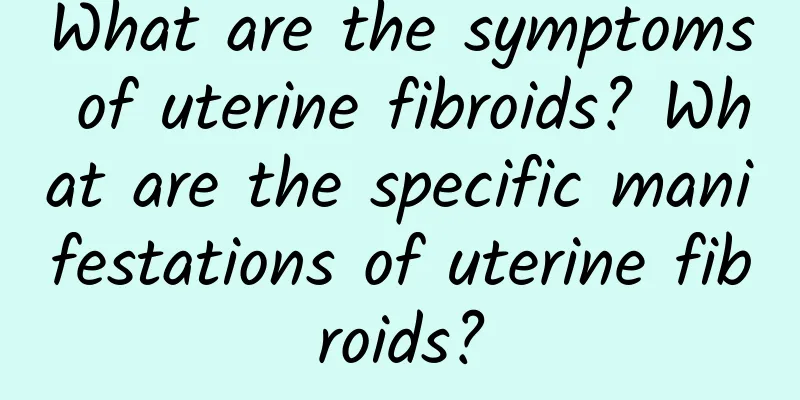What are the symptoms of uterine fibroids? What are the specific manifestations of uterine fibroids?

|
Uterine fibroids are one of the most common benign tumors in the female reproductive organs and one of the most common tumors in the human body. They are also called fibroids and uterine fibroids. Because uterine fibroids are mainly composed of the proliferation of uterine smooth muscle cells and a small amount of fibrous connective tissue exists as supporting tissue, they are more accurately called uterine leiomyoma. Uterine fibroids. What are the specific symptoms of uterine fibroids? The symptoms of uterine fibroids have no obvious characteristics in the early stages. Only when the uterine fibroids are large or grow in a special location, will obvious symptoms appear, mainly including the following aspects: Pain: Generally, there is no pain symptom. However, when the fibroids undergo red degeneration or the pedunculated fibroids are twisted, the submucosal fibroids stimulate the spasmodic contraction of the uterus. It can cause acute abdominal pain. Uterine fibroids can affect women's menstruation, leading to abnormal menstruation and increased bleeding. If uterine fibroids cause long-term menstrual volume, it can lead to secondary anemia. In severe cases, symptoms such as general fatigue, pale complexion, shortness of breath, and palpitations may occur. Menstrual changes: Menstrual changes are the most common symptoms of uterine fibroids, which are manifested as increased menstrual volume, shortened cycles, or prolonged menstruation. Irregular bleeding may also occur. Submucosal fibroids can cause bleeding due to increased mucosal area, surface necrosis, and infection. When intramural fibroids are larger, the uterine cavity is enlarged, the endometrial area is enlarged, the uterus contracts poorly, or there is excessive endometrial hyperplasia, which is manifested as shortened menstrual cycles, increased menstrual volume, and prolonged menstrual periods. Increased vaginal discharge is common in larger intramural fibroids. Due to the increase in the uterine cavity and the increase in glandular secretions, leucorrhea increases; when submucosal fibroids are accompanied by infection, the amount of leucorrhea is also large and sometimes bloody. Compression symptoms: The increase of fibroids will compress nearby organs and produce various symptoms. For example, uterine wall fibroids or cervical fibroids can compress the bladder, urinary frequency, urinary dysfunction, urinary retention, etc. Compression of the ureter can cause hydronephrosis. Uterine posterior wall fibroids can squeeze the rectum, causing difficulty in defecation. Infertility: 25~35% of patients with uterine fibroids may become infertile because the fibroids prevent the fertilized egg from implanting or the sperm from entering the fallopian tube. |
Recommend
Is chocolate cyst serious?
Are chocolate cysts serious? Under normal circums...
The main symptom of uterine fibroids is vaginal bleeding
In gynecology, the symptoms of uterine fibroids a...
Prevent cervical erosion and protect women's health
Cervical erosion is terrible for female friends, ...
Reproductive tract malformations may be the key to causing dysmenorrhea
Reproductive tract malformation may be the key to...
How should patients with cervical erosion usually take care of themselves? Three nursing methods for female cervical erosion
Cervical erosion is very annoying for a woman. If...
What are the changes of uterine fibroids in a week? How big can uterine fibroids grow in a week?
What are the changes in uterine fibroids in a wee...
What are the clinical symptoms of uterine fibroids?
The incidence of uterine fibroids is extremely hi...
Prevention of adnexitis starts with good living habits
Good living habits are very important for prevent...
Traditional Chinese Medicine Nursing for Hyperprolactinemia
What is the reason for high prolactin (PRL)? Exce...
Dietary adjustment for functional uterine bleeding in adolescence
Dysfunctional uterine bleeding is one of the comm...
Summer road running doesn’t hurt your heart! Understand the 2 indicators of heart rate protection during exercise
Taiwanese people are crazy about road running, bu...
How to treat gynecological pelvic effusion?
There are many kinds of gynecological diseases, b...
A brief analysis of the three common treatment misunderstandings of chronic pelvic inflammatory disease
It is understood that there are some misunderstan...
Can you lose weight while sleeping? 9 smart ways to lose weight
1. Slim Science Genes can be defied: A study by t...
What should I pay attention to when treating the wound after ectopic pregnancy surgery?
What should I pay attention to when treating the ...









